Hello! I’m back for another episode of my bird/nature photography day at the Ridgefield National Wildlife Refuge. I’m honored you took the time to come read the blog!
Checking the weather last night I noticed that Mon-Thurs looked mostly sunny at the refuge, but I chose Monday to come because the forecast actually called for some high cloudiness –and clear skies for Tues-Thurs. A little bit of sunlight diffusion is welcome as it keeps the harsh shadows down some. Different weather makes better shooting for different kinds of shots. If I’m after some duck shots in pretty blue water or some bird-in-flight (BIF) shots, I welcome partially to fully clear skies. If I’m after shots that don’t involve the sky or water, then my favorite weather is a thin, full, bright overcast that lets a lot of light through, but where shadows are almost all but gone. This doesn’t mean that a nice duck shot is impossible on a cloudy day but it just may make it more challenging if you include water in your shot.
True sun up is now around 7:30 a.m., so I arrived at the refuge at about 7:45. As the forecasters promised, there were plenty of high clouds at least for the first few hours of the day. There was also low-lying fog in some areas, which is a familiar sight at the refuge on cool mornings.
One of my goal’s for today was to practice more on my BIF shots. I have been struggling in this area lately, with mostly out of focus (OOF) shots. Over the last couple of months, I have changed the lens I shoot with (went from the Canon 100-400 to the Canon 400 f5.6L prime) and I have also upgraded my camera body from the 40D to the 7D. Now, I can hear folks saying to themselves, “He’s got a premiere BIF lens and one of the most advanced crop sensor camera bodies and he’s still having trouble?? There must be something he’s doing wrong!” And you know, those folks are probably right to say that! I have some online buddies who have the same set up I have and produce unbelievable BIF’s–just like they are supposed to!
So, other than the excuse that my technique just stinks, I think the change in lenses could be a change that has affected my BIF shots the most since I am now without IS (image stabilization). When I was shooting with the zoom lens, I remember being pleasantly surprised with how many in-flights came out pretty sharp. This may have something to do with my struggles now that I am using the non-IS prime lens. But I also recall that it took me some time to get used to my then new, 100-400 coming from a Sigma Bigma (50-500mm lens). So I’m hoping that more practice with the new lens will help me to settle into it. A little “seat” time is sometimes needed with new equipment!
Another variable in all of this is the switch from the 40D to the 7D. The 7D has a whole new AF system with many combinations of ways to set it for different situations. Since I got my 7D a few weeks ago, I have been shooting BIF’s with the center AF point active, as I did with the 40D. As I mentioned above–things have not been going well for me in the BIF arena! So, today I am going to try one of the new features of the 7D AF, and that is “Zone AF” where you can choose one of five clusters of AF points (or zones) to be where the camera focuses. Each cluster that you can choose from has between 5 and 9 AF points, all of which try to achieve focus on the nearest object. I have to say, I did have some luck today–better than last week with the number of in focus BIF’s. Nothing that will knock you off your chair but something I call at least “decent.” I’ll get to these shots later in this writeup.
For now though, I head out on the 4.2 mile auto tour of the Ridgefield “River S Unit” and make the first left turn at the hunter’s gate where I am now traveling south near posts # 5, 6, & 7. There is beautiful morning light to my right hitting against the banks of tall blackberry bushes mixed in with trees. I noticed movement in the blackberry bushes so I stop to see what it is. Several European Starlings were hopping around grabbing berries. They never did hop out onto a clear perch but I got some frames of their heads sticking out from behind the leaves. [Remember, you can click on any of the photos for a much larger image].
This is about as exciting as it got on my first loop around the tour–disappointing because I felt like a lot of good light went to waste! I did stop along the Rest Lake stretch between 12 and 13, where the light out on the lake was quite pretty. There was a GBH out there too, so I shot a “landscape” with my telephoto lens taking in the different colors of the refuge terrain and the calm reflection of the heron in the water.
At this point, I hadn’t come across any great opportunities for some BIF practice either but I’m here for 6 to 7 hours so all is not lost–I’ll be driving the tour 3 or 4 more times today.
Second time around the loop and again my attention gets drawn to the blackberry bushes off to my right near post 6 or 7. Much of this area is a wall of blackberry bushes rising 10 feet in places. I saw something move in the bushes out of the corner of my eye…at least two raccoons were at about the 8-foot high level with their heads sticking out of the bushes, munching on blackberries. I stopped the truck and shot many frames of these guys making their way through these stickery bushes–amazing they could climb to that height in these bushes without incurring some kind of pain.
I’m now in the ash tree forest just passing post 9. As I approach the left turn here, I always check this one unobstructed perch off to the right that is the dead snag of a tree that is on the far side of the slough. The end of the snag hangs out over the water and is a favorite perch of the somewhat elusive, Belted Kingfisher. The perch is a little farther away than I like for a bird of Kingfisher size but we take what we can get, right?
Anyway, this time around, there happens to be a beautiful male Kingfisher perched on the snag. Light isn’t perfect but it’s not bad. I start shooting frames on burst mode, pausing shots when the bird turns its head a little too far to its right, which casts a shadow on the near side of its head. Most of the time he cooperated and looked straight ahead or even at a slight angle toward me, casting good light on the head and eye. He stayed there for a minute and a half before flying off to his next destination. I shot 41 frames in about 90 seconds, the image below being the best of the bunch. That’s not many frames for 90 seconds, indicating my selective shooting style.
Continuing around the auto route, I reach the cattails off to the left that are between posts 10 & 11. This is the same area where last week, I shot the Marsh Wren on Cattail photo. I didn’t see any wrens this time but instead saw a Song Sparrow on a cattail and came up with this image. I almost ditched this shot due to the uneven lighting on the sparrow but, after another look, couldn’t help liking the glow of the background, being lightest where the bird is the darkest.
Along south Rest Lake approaching post 12, I saw an Egret and a GBH. I shot some video of the heron and the frames of the egret had too harsh a light for my taste.
There are a gazillion geese out in Rest Lake as I drive past the 3-tree area. I stopped and practiced on some BIF’s with little luck, mainly due to the distance the birds were out in the lake. As I continue on past post 13 where the fields are, I notice when looking east toward the sun, there are almost never ending pockets of small insects hovering about five feet above the ground. The backlight of the sun emphasizes these pockets. I attempted a shot of one of the pockets using manual focus as the AF couldn’t pick up on these transparent pockets.
On the third time around the loop, I came across a family of five raccoons on the far side of the slough, just past the blind parking lot. I watched as the raccoons would go into the shallow water and make digging movements underwater with their front legs, that appeared like they were feeling for something on the floor of the slough, then bringing their paws up to their mouths with some morsel to eat. I took lots of shots and some video, of which some appear below.
A beautiful Red-tailed Hawk was my next sighting, perched off to the right, just 10-12 feet up, as I entered the ash tree forest again. This bird was not concerned with me in the least and stayed there for 5 – 10 minutes before flying off. This wasn’t an ideal location as the background was a little brighter than I would have liked. But the unobstructed view was wonderful.
As I mentioned earlier, I decided to try using the 7D’s new Zone AF setting to see if it might help me with my apparent aiming/technique problem with BIF’s. During the morning hours, stopping along the left side of the road in front of Rest Lake (between posts 12 & 13) is a great place for shots since you are facing north and the light comes from righ to left. Of course, having to stay in the vehicle (refuge rules) and shoot through the driver’s side window is somewhat limiting and presents a little more of a challenge.
I was pleased with the above shot although this is one of the easier flight shots to get– from underneath, as opposed to a side shot.
I stayed at this location a while and shot basically anything that flew within range. Geese were the most numerous.
I then moved forward, past post #14 on the home stretch, and took some long range shots of a female harrier. She was way too far away but one of the frames shows she has a vole in her beak as she was flying to a spot to eat her meal. I can’t bring myself to post the crummy shot!
On my last drive around the loop, I came upon a Scrub Jay on a post near the Kiwa Trail entrance, post #8. He gave me some sweet poses and I was happy with the way some of these turned out.
Now, back to the cattail patch just past post #10. Another Song Sparrow (possibly the same bird as in my earlier shot) on the cattail.
That about does it for Monday, Oct. 18, 2010, at the Refuge. I truly hope you liked something you saw posted here today on the blog! Please visit me on Flickr (guitarman4) if you have a few minutes. Thanks a bunch for stopping by and accompanying me on my nature journey!
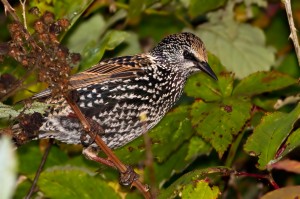
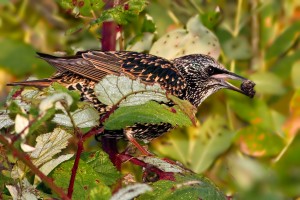

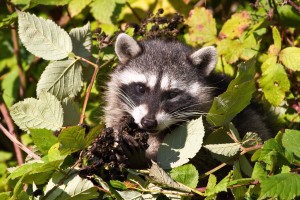
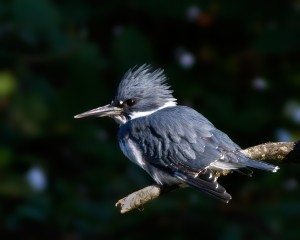

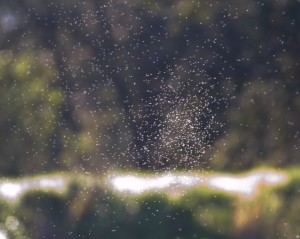
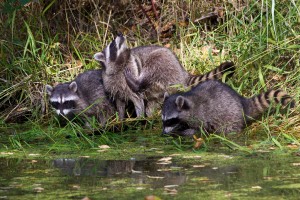
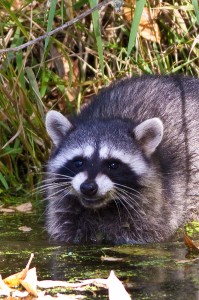
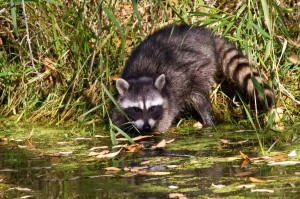
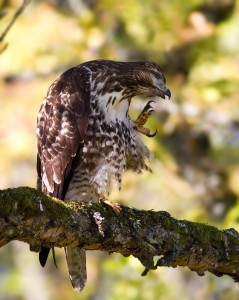
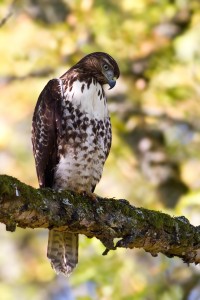
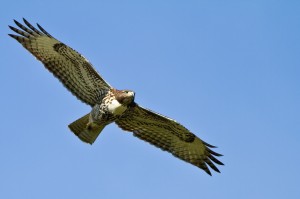
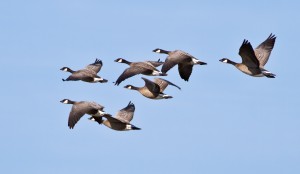

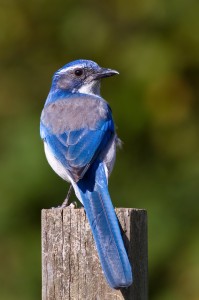

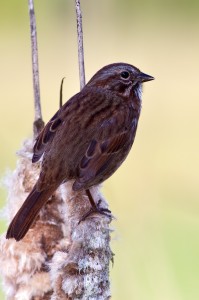
Thanks for providing me with the link to your blog. I am going to bookmark it and visit every day if time allows. Wonderful text and pics explaining where and what wildlife you saw while at the refuge last Monday. It’s always a successful visit if you see raccoons…..how neat to see them inside the berry bushes and then along the water’s edge.
This is so well written and an excellent source of info…esp for those of us who haven’t been able to get out there as much as we’d like.
Congrat’s on your new camera body. Which lens did you use to capture these pics?
Thank YOU Rebecca for taking the time to visit my new site! In case you didn’t notice, I have my 2 previous weeks visits up on the blog, too! Also, I’m trying to add more shots in the photo area of the site. As far as lenses go, I’m now shooting with the Canon 400mm f5.6L prime. I appreciate your kind words!
You had some great light on those raccoons! What made you make the switch from the 100-400 to the 400 prime?
Thanks Arman! It was a great raccoon day for me.
Regarding the 100-400. I used the zoom lens for over 2 years. It was my first Canon super tele. I picked it over the 400mm prime at the time due to its obvious flexibility and IS. I also knew it could take sharp shots as I was reviewing the shots of those who had the lens and who knew how to use it. As I mentioned earlier in a PM, it took me a little while to settle into the lens and get comfortable with it. Once I did, I loved the lens.
You know how it is when after a while you want to try something different? That’s what happened and I started thinking about the 400 f5.6 prime lens. It’s common knowledge that, everything else being equal, a prime lens is a little sharper than a zoom lens. I decided to buy the 400, give it a spin, and then decided if I wanted to keep both lenses or, pick one and sell the other. After a couple of months shooting with the prime, I realized that I liked the feel, sharpness, and weight of it and I wasn’t missing any real close shots that I might have only gotten with the zoom–there’s a major difference in the minimum focusing distance. I do miss the lack of IS in the prime but I’m getting used to it. The other determining factor to sell the zoom lens was that I could recoup more dollars to put toward a camera body upgrade. Best case scenario would have been to hang on to both lenses but I wanted the body upgrade and the 2 lenses were a duplication in many respects.
Both are fine lenses and wonderful shots can be taken with either!